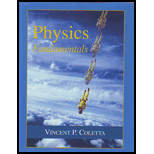
Concept explainers
(a)
The mass of the dust.
(a)
Answer to Problem 70P
Explanation of Solution
Given Data:
Formula Used:
The Potential energy of the comet at the surface of earth is given as:
Mass of the dust
Calculation:
Gravitational Potential energy of comet:
The half of the gravitational potential energy is used to hold the dust particles:
Mass of the dust is calculated as below:
Conclusion:
Mass of the dust is
(b)
The mass density of the dust.
(b)
Answer to Problem 70P
Explanation of Solution
Introduction:
Density is defined as mass per unit volume:
The dust lies from earth’s surface to 20 Km in the atmosphere. Therefore, the distance is from R to R+20 Km.
The Volume between thesedistances is given as below:
Density of dust:
Conclusion:
Density of the dust is
Want to see more full solutions like this?
Chapter 7 Solutions
Physics Fundamentals
- Find the escape speed of a projectile from the surface of Jupiter.arrow_forwardCheck Your Understanding The nearly circular orbit of Saturn has an average radius of about 9.5 AU and has a period of 30 years, whereas Uranus averages about 19 AU and has a period of 84 years. Is this consistent with our results for Halley’s comet?arrow_forwardWhat is the ratio of the speed at perihelion to that at aphelion for the comet Lagerkvist in the previous problem?arrow_forward
- Show that the areal velocity for a circular orbit of radius r about a mass M is At=12GMr . Does your expression give the correct value for Earth’s areal vilocity about the Sun?arrow_forwardFind the escape speed of a projectile from the surface of Mars.arrow_forwardAn average-sized asteroid located 5.0107km from Earth with mass 2.01013kg is detected headed directly toward Earth with speed of 2.0km/s . What will its speed be just before it hits our atmosphere? (You may ignore the size of the asteroid.)arrow_forward
- If a Saturn V rocket with an Apollo spacecraft attached had a combined mass of 2.6 × 105 kg and reached a speed of 12 km/s, how much kinetic energy would it then have?arrow_forwardThe figure below shows the potential energy function U(r) of a projectile plotted outward from the surface of a planet of radius Rs. What is the minimum velocity required for a 1.8 kg object to "escape" the gravitational field of the planet.arrow_forwardWhat multiple of the energy needed to escape from Earth gives the energy needed to escape from (a) the Moon and (b) Jupiter?arrow_forward
- If the escape velocity from the surface of earth is 11.3km/s, find escape velocity from the surface of another heavenly body whose mass and diameter are twice of the eartharrow_forwardthe potential energy function U(r) of a projectile, plotted outward from the surface of a planet of radius Rs. If the projectile is launched radially outward from the surface with a mechanical energy of2.0 * 10^9 J, what are (a) its kinetic energy at radius r = 1.25Rs and (b) its turning point (see Module 8-3) in terms of Rs?arrow_forwardShow that the values vA and vP of the speed of an earth satellite at the apogee A and the perigee P of an elliptic orbit are defined by the relationswhere M is the mass of the earth, and rA and rP represent, respectively, the maximum and minimum distances of the orbit to the center of the earth.arrow_forward
 Classical Dynamics of Particles and SystemsPhysicsISBN:9780534408961Author:Stephen T. Thornton, Jerry B. MarionPublisher:Cengage Learning
Classical Dynamics of Particles and SystemsPhysicsISBN:9780534408961Author:Stephen T. Thornton, Jerry B. MarionPublisher:Cengage Learning University Physics Volume 1PhysicsISBN:9781938168277Author:William Moebs, Samuel J. Ling, Jeff SannyPublisher:OpenStax - Rice University
University Physics Volume 1PhysicsISBN:9781938168277Author:William Moebs, Samuel J. Ling, Jeff SannyPublisher:OpenStax - Rice University

